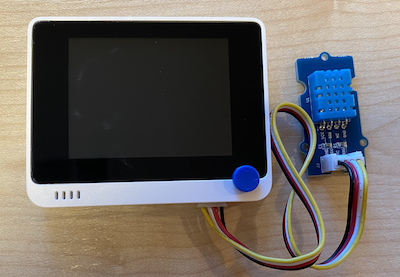Measure temperature - Wio Terminal
In this part of the lesson, you will add a temperature sensor to your Wio Terminal, and read temperature values from it.
Hardware
The Wio Terminal needs a temperature sensor.
The sensor you'll use is a DHT11 humidity and temperature sensor, combining 2 sensors in one package. This is fairly popular, with a number of commercially available sensors combining temperature, humidity and sometimes atmospheric pressure. The temperature sensor component is a negative temperature coefficient (NTC) thermistor, a thermistor where the resistance decreases as the temperature increases.
This is a digital sensor, so has an onboard ADC to create a digital signal containing the temperature and humidity data that the microcontroller can read.
Connect the temperature sensor
The Grove temperature sensor can be connected to the Wio Terminals digital port.
Task - connect the temperature sensor
Connect the temperature sensor.

-
Insert one end of a Grove cable into the socket on the humidity and temperature sensor. It will only go in one way round.
-
With the Wio Terminal disconnected from your computer or other power supply, connect the other end of the Grove cable to the right-hand side Grove socket on the Wio Terminal as you look at the screen. This is the socket farthest away from the power button.

Program the temperature sensor
The Wio Terminal can now be programmed to use the attached temperature sensor.
Task program the temperature sensor
Program the device.
-
Create a brand new Wio Terminal project using PlatformIO. Call this project
temperature-sensor. Add code in thesetupfunction to configure the serial port.⚠️ You can refer to the instructions for creating a PlatformIO project in project 1, lesson 1 if needed.
-
Add a library dependency for the Seeed Grove Humidity and Temperature sensor library to the projects
platformio.inifile:lib_deps =
seeed-studio/Grove Temperature And Humidity Sensor @ 1.0.1⚠️ You can refer to the instructions for adding libraries to a PlatformIO project in project 1, lesson 4 if needed.
-
Add the following
#includedirectives to the top of the file, under the existing#include <Arduino.h>:#include <DHT.h>
#include <SPI.h>This imports files needed to interact with the sensor. The
DHT.hheader file contains the code for the sensor itself, and adding theSPI.hheader ensures the code needed to talk to the sensor is linked in when the app is compiled. -
Before the
setupfunction, declare the DHT sensor:DHT dht(D0, DHT11);This declares an instance of the
DHTclass that manages the Digital Humidity and Temperature sensor. This is connected to portD0, the right-hand-side Grove socket on the Wio Terminal. The second parameter tells the code the sensor being used is the DHT11 sensor - the library you are using supports other variants of this sensor. -
In the
setupfunction, add code to set up the serial connection:void setup()
{
Serial.begin(9600);
while (!Serial)
; // Wait for Serial to be ready
delay(1000);
} -
At the end of the
setupfunction, after the lastdelay, add a call to start the DHT sensor:dht.begin(); -
In the
loopfunction, add code to call the sensor and print the temperature to the serial port:void loop()
{
float temp_hum_val[2] = {0};
dht.readTempAndHumidity(temp_hum_val);
Serial.print("Temperature: ");
Serial.print(temp_hum_val[1]);
Serial.println ("°C");
delay(10000);
}This code declares an empty array of 2 floats, and passes this to the call to
readTempAndHumidityon theDHTinstance. This call populates the array with 2 values - the humidity goes in the 0th item in the array (remember in C++ arrays are 0-based, so the 0th item is the 'first' item in the array), and the temperature goes into the 1st item.The temperature is read from the 1st item in the array, and printed to the serial port.
🇺🇸 The temperature is read in Celsius. For Americans, to convert this to Fahrenheit, divide the Celsius value read by 5, then multiply by 9, then add 32. For example, a temperature reading of 20°C becomes ((20/5)*9) + 32 = 68°F.
-
Build and upload the code to the Wio Terminal.
⚠️ You can refer to the instructions for creating a PlatformIO project in project 1, lesson 1 if needed.
-
Once uploaded, you can monitor the temperature using the serial monitor:
> Executing task: platformio device monitor <
--- Available filters and text transformations: colorize, debug, default, direct, hexlify, log2file, nocontrol, printable, send_on_enter, time
--- More details at http://bit.ly/pio-monitor-filters
--- Miniterm on /dev/cu.usbmodem1201 9600,8,N,1 ---
--- Quit: Ctrl+C | Menu: Ctrl+T | Help: Ctrl+T followed by Ctrl+H ---
Temperature: 25.00°C
Temperature: 25.00°C
Temperature: 25.00°C
Temperature: 24.00°C
💁 You can find this code in the code-temperature/wio-terminal folder.
😀 Your temperature sensor program was a success!